

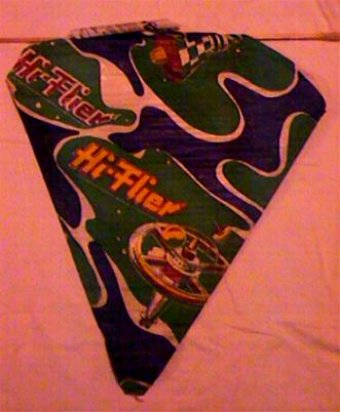
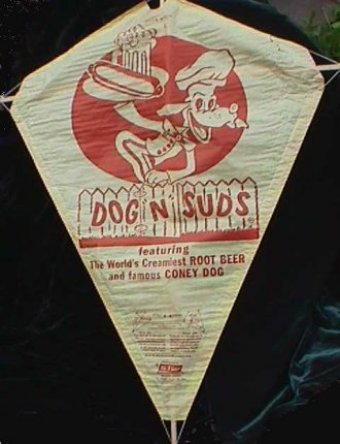
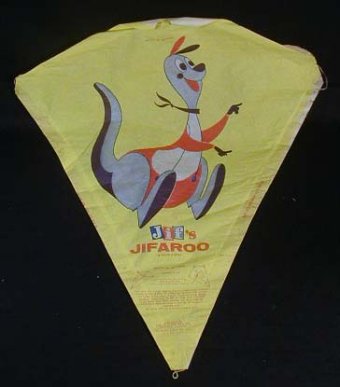
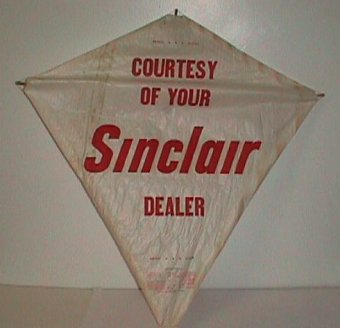
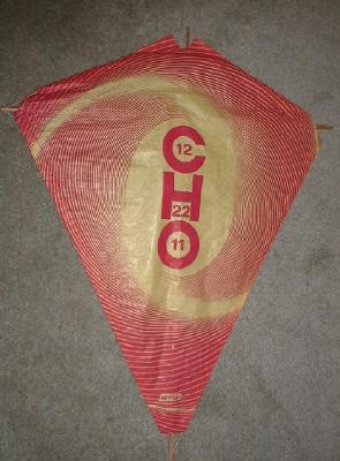
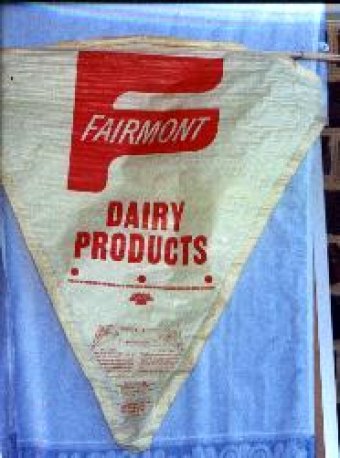
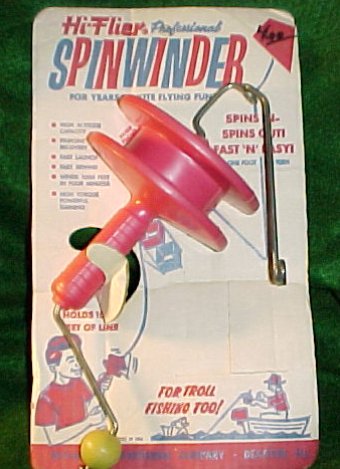
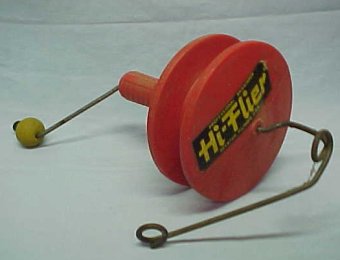
(Hey, can any of you add any facts to this summary? Please send me whatever you can at jeffd@coriolis.com.)
OK. There were three kite different designs in the Hi-Flier canon during the time I flew them. Two are well known, and the third I have seen only once, probably in 1966. Here's the summary:
And that's it! If there any additional types I never saw them.
These were my favorites. Two coke bottles found in an empty lot could be returned at the C&T Certified at
Canfield and Talcott (around the corner from Bud's hardware store) and generate funds to buy one. I remember two
designs and two only:
1. The “Playmates of the Clouds.” These were one-color on white paper, often black but I remember having them in
blue and magenta inks. The design had a futuristic flying wing aircraft in the center, above the name “Hi-Flier.”
They fascinate me because the ones I bought always had biggish numbers on them below the logo. I remember having
one with the a number as small as 6, and as high as 94. Interestingly, I saw one on Ebay recently that had the
words “Little Boy” in place of the numbers.
2. The American Shield kites. These were the same size, but more colorful, and lots of kids seemed to be flying
them after the Fourth of July. I couldn't sketch one anymore, but they were red, white, and blue, with stars and
stripes and a shield.
The 10 cent Hi-Fliers were wonderful flyers. In most Chicago winds that we dared fly in, they would fly tailless
with very little trouble. In fact, on a dare I tried flying one upside-down by pulling the bridle tie point way
down the bridle string and flipping it over. Worked fine! It looked like an arrow, and the other kids thought I
was pretty clever to have pulled it off. Most of them never mastered kite flying, generally because they persisted
in tying entire bedsheets off the bottom stick and wondering why the damned things couldn't get off the ground.
I don't remember these as well, because I only flew a couple. One of my friends preferred them. He was smart, and figured out (as most kids never did) that a bigger kite would fly in less wind. I didn't like them because they cost another redeemed bottle to buy, and once in the air it was impossible to tell that they were any bigger than my Playmates of the Clouds. And at the rate I wrecked kites (and with plenty of competition for scavenged bottles) it seemed an unwarranted profligacy.
These cost a quarter, and when I had quarters—which wasn't often—I bought better things than kites. I remember flying a couple with my cousin Ron down in Blue Island. Ron was always spoiled and had the best toys, including the biggest Erector set I ever saw. The Hi-Flier plastic bow kites, as far as I knew, had only one design: A Flash-Gordon style spacecraft with the legend “Orbiteer.” I think they came in different color schemes, though. The one I remember most clear was mostly magenta with blue highlights.
I lusted after these, and every so often (usually after Aunt Kathleen had given me a dollar for no good reason)
I would buy one. They had a very simple art design: Just colored paper with relatively small drawings of spaceships
and helicopters and things. The physical design was diabolical: Each end was kept at very high tension by two cross-sticks
that were slightly too long to fit inside the paper box portion, and had to bow a little. The paper was thus tight
as a drum, and tore very easily.
But they flew like demented birds of prey, swooping and zipping around at incredible speeds, pulling tremendously
hard, almost always on the edge of being out of control. Flying one was the first adrenaline rush I can clearly
recall. Each represented a lot of kid-capital, and having seen plenty of them die at other kids' hands, there was
a lot of anxiety in trying to get them to rise and sit still.
Sit still? Hah. No chance. Not even by me, who considered his twelve-year-old self a black-belt kitemaster. In
the strange divided drafts that beset the too-small Edison schoolyard, they flew like crazed eagles, often for
no more than a few seconds before diving full-speed straight down from seventy feet in the air and exploding into
sticks and shreds in the muddy spring grass.
As I got to be twelve and thirteen, I justified the expense of Hi-Flier box kites because after they crashed, I
could scavenge the sticks and build bow kites with the sticks. An unbroken stick was the vertical, and a broken
stick (always at one of the two notches about 3” from the ends) became the bow stick. I covered them with newspaper,
which tore a lot, but was free and abundant in the basement. Eventually I could strip the paper from a kite and
re-string and re-paper it inside of five minutes, although I was covered with mucilage by the time I was done.
Not that I cared. (Does anybody even remember mucilage, and the smushy flesh-colored noses on the bottles that
you used to spread the goop on the paper flaps around the edges of your kite?)
I tried to make a small square flat kite from two of the spreader sticks once, but could never get it into the
air. Small kites take a lot of air, as I learned after awhile.
I didn't know it at the time, but Hi-Flier must have done a tremendous business in promo kites, by which I mean
the small-sized two-stick paper kites on which a business would print its own design and give them to kids as promotional
items. The number of such kites to appear on Ebay is completely incredible. Jif peanut butter, Sinclair and Texaco,
various local businesses and radio stations; it's amazing. Below is a collection of photos I've grabbed from Ebay
auctions showing some of the range of the Hi-Flier product line. Most of the kites to come to auction were promos.
I have one myself; a Big Boy Fan Club kite that literally sat stuck in my mother-in-law's basement rafters for
thirty years before we pulled it out and flew it in 1995.
That's about all I remember about Hi-Flier kites. In the table below are some recent photos of kites to come up
on Ebay. I don't know when the paper kite era came to an end; I would guess the mid or late Seventies.
Hi-Flier sold a couple of other things as well. They sold branded kite line, but it looked like everybody else's light cotton package twine and I suspect it was just a private label thing. The best Hi-Flier product apart from kites, however, was their Spinwinder. I never had one, but I watched a kid use one once, and it made winding string around a lumpy stick look pretty sick by comparison. The device was a spool with a handle, and through the handle was threaded a metal rod that bent into a crank at the bottom, and at the top into a loop that curved down level with the spool. You wound your line on the spool, and then threaded it just so over the bar and through a loop on the end to your kite. As you cranked the handle, the rod spun around and wound in your kite, placing your line neatly and tightly on the spool! The only downside was that letting line out in a hurry was problematic, which is why I still use a "hose-reel" style reel when I fly. I have a couple of pictures of the Spinwinder below, and it remains a pretty cool gadget.
I vaguely recall a very simple bent-wire winder that was much cheaper, but I'm not sure if it was a Hi-Flier product.
Anybody got any more facts? Please let me know, and I'll add them to this account.
 |
 |
 |
 |
 |
 |
 |
 |
 |
 |